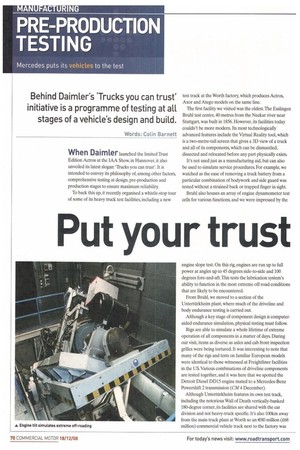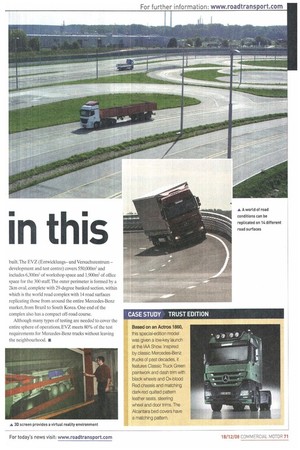Put your trust in this
Page 70

Page 71

If you've noticed an error in this article please click here to report it so we can fix it.
Behind Daimler's 'Trucks you can trust' initiative is a programme of testing at all stages of a vehicle's design and build.
Words: Colin Barnett When Daimter launched the limited 'Rust Edition Actros at the IAA Show, in Hannover, it also unveiled its latest slogan: 'Trucks you can trust'. It is intended to convey its philosophy of, among other factors, comprehensive testing at design, pre-production and production stages to ensure maximum reliability.
To back this up, it recently organised a whistle-stop tour of some of its heavy truck test facilities, including a new test track at the Worth factory, which produces Actros, Axor and Atego models on the same line.
The first facility we visited was the oldest. The Esslingen Bruhl test centre, 40 metres from the Neckar river near Stuttgart, was built in 1856. However, its facilities today couldn't be more modern. Its most technologically advanced features include the Virtual Reality tool, which is a two-metre-tall screen that gives a 3D view of a truck and all of its components, which can be dismantled, dissected and relocated before any part physically exists.
It's not used just as a manufacturing aid, but can also be used to simulate service procedures. For example, we watched as the ease of removing a truck battery from a particular combination of bodywork and side guard was tested without a strained back or trapped finger in sight.
Bruhl also houses an array of engine dynamometer test cells for various functions, and we were impressed by the engine slope test. On this rig, engines are run up to full power at angles up to 45 degrees side-to-side and 100 degrees fore-and-aft. This tests the lubrication system's ability to function in the most extreme off-road conditions that are likely to be encountered.
From Bruhl, we moved to a section of the Unterttirkheim plant, where much of the driveline and body endurance testing is carried out.
Although a key stage of component design is computeraided endurance simulation, physical testing must follow.
Rigs are able to simulate a whole lifetime of extreme operation of all components in a matter of days. During our visit, items as diverse as axles and cab front inspection grilles were being tortured. It was interesting to note that many of the rigs and tests on familiar European models were identical to those witnessed at Freightliner facilities in the US. Various combinations of driveline components are tested together, and it was here that we spotted the Detroit Diesel DD15 engine mated to a Mercedes-Benz Powershift 2 transmission (CM 4 December).
Although Unterttirkheim features its own test track, including the notorious Wall of Death vertically-banked 180-degree comer, its facilities are shared with the car division and not heavy-truck specific. It's also 1001un away from the main truck plant at Worth so an €80 million (£68 million) commercial vehicle track next to the factory was built. The EVZ (Entwicklungs— und Versuchszentrum — development and test centre) covers 550.000m2 and includes 6,300m2 of workshop space and 1,900m2 of office space for the 300 staff The outer perimeter is formed by a 2km oval, complete with 29-degree banked section, within which is the world road complex with 14 road surfaces replicating those from around the entire Mercedes-Benz market, from Brazil to South Korea. One end of the complex also has a compact off-road course.
Although many types of testing are needed to cover the entire sphere of operations, EVZ meets 80% of the test requirements for Mercedes-Benz trucks without leaving the neighbourhood. •




































































































































































